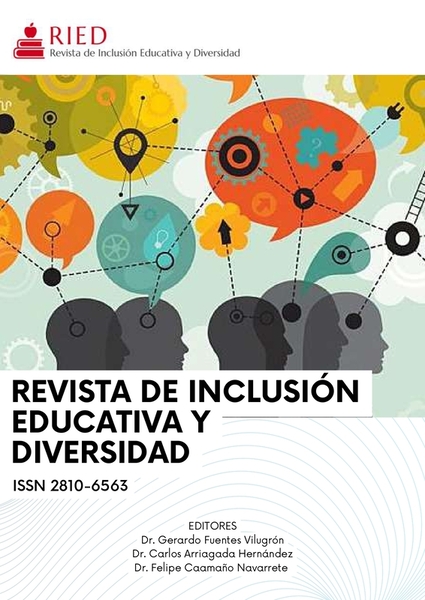The Importance of Communication and Family Participation in the Education of Children with ASD: Implications for Family Quality of Life.
DOI:
https://doi.org/10.5281/zenodo.15923164Keywords:
Family involvement, autism spectrum disorder, family quality of life, inclusive education, Special educational needsAbstract
Introduction. This study examines the influence of educational settings and family involvement on the quality of life of families with children aged 0 to 6 years diagnosed with Autism Spectrum Disorder (ASD). Method. A total of 101 families participated, with children enrolled in special education, ASD-specific classrooms, or mainstream education with support. An ad hoc questionnaire was used to collect sociodemographic data, information about communication and family participation in the school, along with the Family Quality of Life Scale. Data were analyzed using Spearman’s correlation and the Kruskal-Wallis test and multiple linear regression. Results. Results revealed a significant positive correlation between family participation and communication with the school (Rho = .41, p < .001), as well as between family participation and family quality of life (Rho = .22, p < .05). Regression analysis revealed that both participation and communication were significant predictors of family quality of life (p < .001), whereas educational placement showed no significant effects. The findings highlight the importance of family involvement in the educational context of children with ASD, showing that greater participation is associated with improved perceptions of family quality of life. Promoting family-school collaboration is essential to support family well-being.
Downloads
References
Alabdulkarim, A. (2023). Families of children with autism and stress: A scoping review. International Journal of Technology and Inclusive Education (IJTIE), 12(1). https://doi.org/10.3109/01612840.2015.1116030
American Psychiatric Association. (2013). Diagnostic and statistical manual of mental disorders (APA, Ed.; 5th ed.).
De Rivera Romero, T. G., Fernández-Blázquez, M. L., Rueda, C. S., & Sarrionandia, G. E. (2022). Inclusive education of students with ASD: A systematic review of the research. In Siglo Cero (Vol. 53, Issue 1, pp. 115–135). University of Salamanca. https://doi.org/10.14201/scero2022531115135
Dunst, C. (2004). An integrated framework for practising early childhood intervention and family support. Perspectives in Edu-cation, 22. https://doi.org/ 10.1007/978-3-319-28492-7_3
Escobar-Villacrés, L., Sánchez-López, C., Andrade-Albán, J., & Saltos-Salazar, L. (2024). El trastorno del espectro autista (tea) y los métodos de enseñanza para niños en el aula de clases. 593 Digital Publisher CEIT, 9(1–1), 82–98. https://doi.org/10.33386/593dp.2024.1-1.2263
Fachado, A. A., Menéndez Rodríguez, M., & González Castro, L. (2013). Apoyo social: mecanismos y modelos de influencia sobre la enfermedad crónica. Cad Aten Primaria, 19.
Giné, C., Mas. J. M., Balcells-Balcells, A., Baqués, N., & Simón, C. (2019). Escala de Calidad de Vida Familiar para familias con hijos/as menores de 18 años con discapacidad intelectual y/o en el desarrollo. Versión Revisada 2019. CdVF-ER(<18). (Plena Inclusión, Ed.).
Hastings, R. P., & Brown, T. (2002). Stress in family caregivers of children with autism. The Journal of Autism and Developmental Disorders, 32(4), 299–310. https://doi.org/10.1177/08830738155797
LOMLOE. (2020). Ley Orgánica de Modificación de la Ley Orgánica de Educación. 3/2020. In Boletín Oficial del Estado.
Lord, C., Rutter, M., DiLavore, C., Luyster, R. J., & Gotham, K. (2024). Escala de Observación para el diagnóstico de autismo. ADOS-2.
McWilliam, R. A. (2010). Family Assessment Natural Environments (Paul H. Brookes, Ed.; APPENDIX).
McWilliam, R. A. (2015). Future of Early Intervention with infants and toddlers for whom typical experiences are not effective. Remedial and Special Education, 36(1), 33–38. https://doi.org/10.1177/0741932514554105
Ramírez-Ochoa, J., & Orellana-Yáñez, A. (2018). Autoeficacia de cuidadores familiares de niños/as con trastornos del espectro autista: revisión integrativa. SANUS Revista de Enfermería, 3(7). https://doi.org/10.36789/sanus.vi7.99
Rodas Jara, R., Franco, N. M., Rodas Jara, L. R., Franco, F., Gómez Leiva, E., Villalba Salinas, D., Chromey, N., Torales, J. C., & Báez, D. (2023). Apoyo, Desafíos y Oportunidades de una Persona con el Trastorno del Espectro Autista en Paraguay: Análisis desde la Perspectiva de los Padres. Revista Científica Ciencias de La Salud, 5, 01–07. https://doi.org/10.53732/rccsalud/2023.e5108
Rogers, S. J., & Dawson, G. (2024). Modelo Denver de Atención Temprana para niños pequeños con autismo (Autismo Ávila).
Shalock, R. L., & Verdugo, M. Á. (2007). El concepto de calidad de vida en los servicios y apoyos para personas con discapacidad intelectual. Revista Española Sobre Discapacidad Intelectual, 38(244), 21–36.
The jamovi project. (2022). The jamovi project. Jamovi. (Version 2.3) [Computer Software].
Turnbull, A. P., Turbiville, V., & Turnbull, H. R. (2000). Evolution of family–professional partnerships: Collective empowerment as the model for the early twenty-first century. Handbook of Early Childhood Intervention, 630–650. https://doi.org/10.1017/CBO9780511529320.029
Valero, R., Serrano, A. M., McWilliam, A. R., & Cañadas, M. (2020). Variables predictoras del empoderamiento familiar en prácticas de atención temprana centradas en la familia. Revista de Logopedia, Foniatría y Audiología, 40(3). https://doi.org/10.1016/j.rlfa.2020.05.003
Vasilopoulou, E., & Nisbet, J. (2016). The quality of life of parents of children with autism spectrum disorder: A systematic review. Research in Autism Spectrum Disorders, 23, 36–49. https://doi.org/10.1016/j.rasd.2015.11.008Obtener derechos y contenido
Zablotsky, B. (2013). The impact of autism spectrum disorder on family quality of life. Autism, 17(1), 1–10.
Zambrano-Mendoza, A. I., & Lescay-Blanco, D. M. (2022). Rol de la familia en la calidad de vida y autodeterminación de las personas con trastornos del espectro autista. Revista Científica Arbitrada En Investigaciones de La Salud GESTAR, 5(9 Edicion especial abril), 41–77. https://doi.org/10.46296/gt.v5i9edespab.0064
Zeidan, J., Fombonne, E., Scorah, J., Ibrahim, A., Durkin, M. S., Saxena, S., Yusuf, A., Shih, A., & Elsabbagh, M. (2022). Global prevalence of autism: A systematic review update. In Autism Research (Vol. 15, Issue 5, pp. 778–790). John Wiley and Sons Inc. https://doi.org/10.1002/aur.2696
Zimmerman, B. J., Kitsantas, A., & Campillo, M. (2005). Evaluación de la Autoeficacia Regulatoria: Una Perspectiva Social Cognitiva. https://doi.org/10.35670/1667-4545.v5.n1.537
Downloads
Published
Issue
Section
License
Copyright (c) 2025 Ana Muiño Tato (Autor/a)

This work is licensed under a Creative Commons Attribution-NonCommercial 4.0 International License.
Reconocimiento – No comercial: El material creado por usted puede ser distribuido, copiado y exhibido por terceros si se muestra en los créditos. No se puede obtener ningún beneficio comercial.






